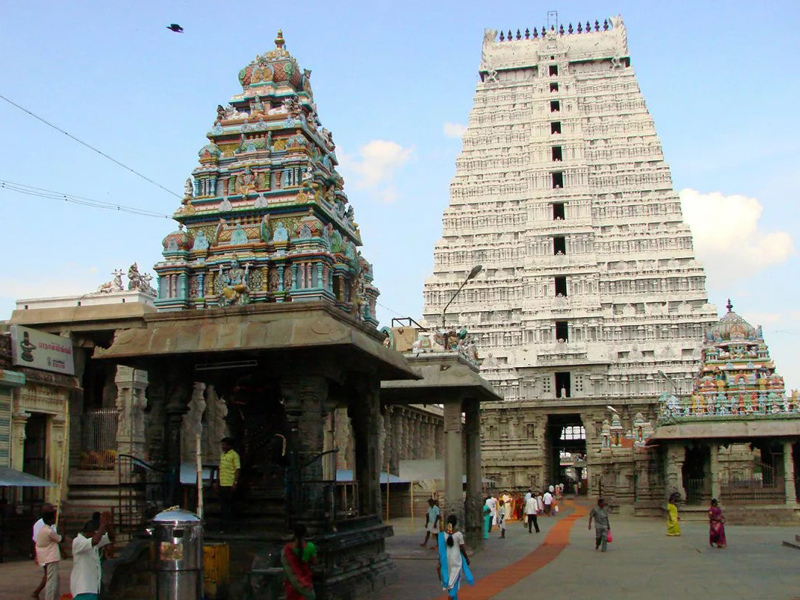The story that revolves around this temple is about Lord Shiva appearing as a column of light or fire to eliminate the ego from the face of mankind. The story begins with two most revered Hindu deities and part of the Trimurthis [Three governing Hindu Gods] Lord Vishnu the preserver and Lord Brahma the creator argues with each other to impose the supremacy of one self over the other. Lord Brahma said he is supreme among the Trimurthis and he was born first. Lord Vishnu stated that Lord Brahma emerged from his navel only. While both were fighting, there comes Lord Shiva for the rescue. He appeared between the two Lords in the form of a column of fire and asked both of them to find the end of this free column. He declared that the one who finds the end is the most supreme of the Trimurthis. Therefore Lord Vishnu as Varaha [Boar] and Lord Brahma as swan started moving toward both sides separately. Lord Brahma on the way found a Thazhambu flower and asked her to be a false witness. On returning Lord Brahma asked the flower to tell Shiva that he found the end. The flower said so to Shiva which made him so angry that he cursed Brahma that he would not have any temple worshipping him on Earth and also cursed the flower that it would not be used for any pooja kriyas. Lord Vishnu after realizing there is no end to the fire column accepts defeat and bow to Shiva. This fire column is said to be represented by the Arunachala Hills next to the Arunachaleswarar Temple. This fire column is considered as the original symbol of the lingam, the source of creation which has no beginning and no end. It is omnipresent in the cosmos throughout the galaxies and the endless cosmic ocean.
The Arunachaleswarar temple which spans an area around 25 acres is one of the largest in India. The temple dates nearly thousand years, but most of its present structure include modifications during the 17th and 19th centuries. On entering the temple you will feel your attention driving towards the Thousand Pillared Mandapa on your right. It is a symbol of Tamil Nadu temples which is a part of all the majestic marvels at Tamil Nadu. The next striking feature your eyes might fall on is the large tank on your left side. Then to your front there is another gateway which leads to the inner sanctum where the Shiva Agni Linga is worshipped. The view of the temple is best enjoyed standing atop the sacred Mount Arunachala. Climbing this 800 m hill is definitely a tiresome one with unstable rocks and the Sun draining your energy every step you take, but it is pure enlightenment you experience when you reach at the top of the hill. The spectacular view of the Arunachaleswarar temple from her is worth all the energy you drain.
Temple Timings:
The temple is open to worship for the devotees during morning hours 5:30am to 12:30pm and evening 3:30pm to 9:30pm.
| POOJA DETAILS | TIMINGS | POOJA DETAILS | TIMINGS | POOJA DETAILS | TIMINGS |
|---|---|---|---|---|---|
| Ukshakala Pooja | 5.30 A.M | Kala Shanti Pooja | 8.00 A.M | Uchi Kala Pooja | 11.30 A.M |
| Sayaratchai Pooja | 5.30 P.M | Irandam Kala Pooja | 7.30 P.M | Arthajama Pooja | 9.00 P.M |
Major Festivals
All the festivals celebrated here at Arunachaleswarar Temple are considered auspicious and is visited by millions every year. Following is an annual festival chart provided by the temple authorities themselves. However the Karthigai Deepam festival popularly known as Karthigai Brahmotsavam celebrated during the Karthigai month [November- December] is the major festival here at Arunachaleswarar Temple. The Maha deepam lit on the Mount Arunachala on the 10th day of the festival is the most auspicious event every year driving millions into the temple.
Tamil Month - Festival Details
Chithirai (April – May) - Chithirai Vasantha Urchavam 10 days.
Vaikasi (May – June) - Vaikasi Urchavam 1 day.
Aani (June – July) - Aani Bramorchavam 10 days. Aani Thirumanjanam (Lord Nataraja Urchavam 1 day).
Aadi (July – August) - Aadi Pooram Bramorchavam 10 days.
Avani (August – Sept.) - Avani Moolam Urchavam 1 day.
Puratasi (Sept. – Oct.) - Navarathri Urchavam 9 days.
Aippasi (Oct. – Nov.) - Annabishekam Urchavam 1 day. Kanda Sashti urchavam 6 days.
Karthigai (Nov. – Dec.) - Karthigai Deepa Bramorchavam 17 days.
Margazhi (Dec. – Jan.) - Vaikunda Ekadasi Urchavam 1 day. Arudra Darisanam (Lord Nataraja Urchavam) 1 day.
Thai (Jan. – Feb.) - Vaikasi Urchavam 1 day. Uttarayana Punyakalam Bramorchavam 10 days. Thiruvoodal Urchavam 1 day. Manalurpettai Theerthavari Urchavam 1 day. Kalasapakkam (Rathasapthami). Theerthavari Urchavam 1 day.
Masi (Feb. – March) - Maha Shivaratri Urchavam. Masi Makam Pallikond Pattu Theerthavari Urchavam.
Panguni (March – April) - Panguni Uthiram Thirukalyana Urchavam 6 days.
How to Reach?
By Air:
The nearest airport is Chennai International Airport 185 kms away. There are flights available to Chennai from all the major cities in India as well as abroad. From Chennai Airport, grab a taxi to Tiruvannamalai or board in a government bus.
By Rail:
The nearest railway stations are Villupuram (76 km) and Katpadi (65 km). There are frequent trains available from all parts of the country that passes through these two stations. Fromm the station you can grab at taxi or board in a government bus to reach Arunachaleswarar Temple.
By Road:
Tiruvannamalai is well connected by road to all the major cities in South India. You can easily connect Tiruvannamalai through bus or car.
